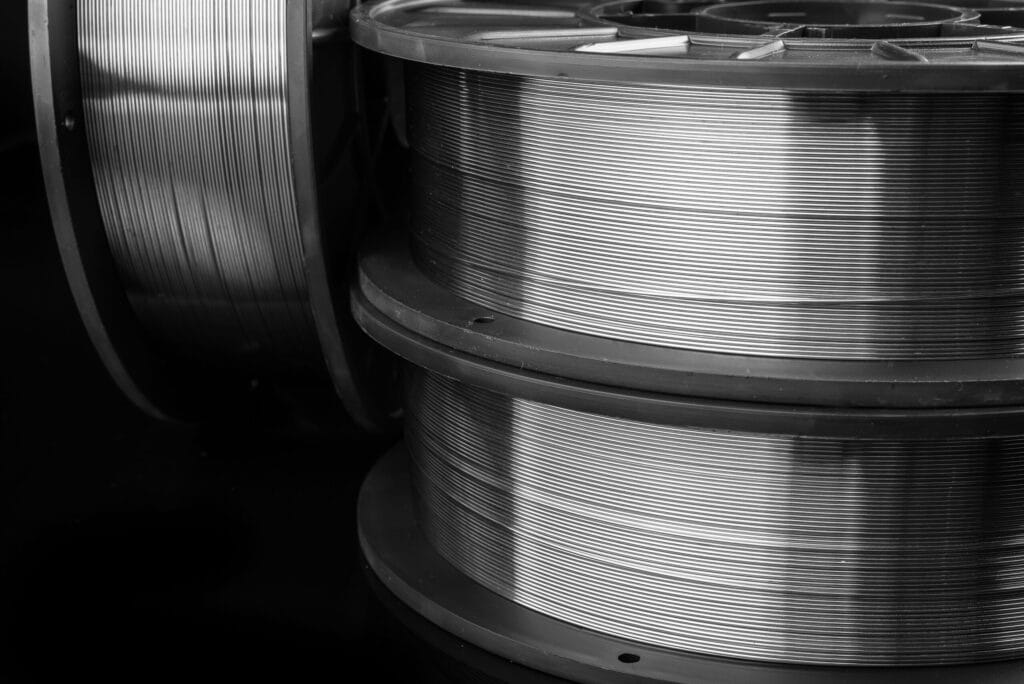As part of our ever-expanding range of metal options, we have teamed up with our sister business The Crazy Wire Company to add a massive collection of raw nichrome wire options.
Having supplied raw wire for many years, we have the knowledge and confidence to provide wire tailored to each application as well as to provide technical assistance. To keep it simple we are offering 1 spool size for each wire specification, but if you do need a specific weight or length then please contact us. We have 6 spooling machines in house, so many bespoke products is simple for us.
Here are a few quick points on why nichrome wire is such a popular option…
How Is Nichrome Wire Made?
Nichrome wire is an alloy composed primarily of nickel (Ni) and chromium (Cr) used as a resistance wire for heating elements in appliances such as electric heaters, toasters, and hair dryers. It has high resistance to corrosion and oxidation, making it suitable for high temperature applications.
Nichrome wire is made through a process called wire drawing. The process involves several steps:
- Melting: The nickel and chromium metals are melted together to form an alloy. The exact composition of the alloy will vary depending on the desired grade of Nichrome wire.
- Cast: The melted alloy is cast into a long rod.
- Annealing: The cast rod is heated to a high temperature and then cooled to improve its ductility, making it easier to draw into wire.
- Drawing: The rod is passed through a series of progressively smaller dies to reduce its diameter and increase its length. This process is called wire drawing. The wire is drawn to the desired thickness, typically between 0.1mm and 5mm.
- Annealing: The drawn wire is annealed again to remove any internal stresses and improve its mechanical properties.
- Coating: The wire may be coated with a protective layer of insulation to prevent it from shorting out or to provide electrical insulation.
- Packaging: The wire is packaged and shipped to customers for use in various applications.
This process results in a high-quality Nichrome wire with consistent resistance and a uniform diameter, making it ideal for use in heating elements and other applications.
What Grades Are There?
There are several grades of Nichrome wire, including:
- Nichrome 80/20: This is the most commonly used grade and is composed of 80% nickel and 20% chromium. It has good resistance to oxidation and is often used in high temperature applications.
- Nichrome 60/15: This grade contains 60% nickel and 15% chromium, with the rest made up of iron. It has a lower resistance to oxidation than Nichrome 80/20 and is often used in applications where lower temperatures are required.
- Nichrome 30/20: This grade contains 30% nickel and 20% chromium and has a lower resistance to oxidation compared to the 80/20 and 60/15 grades. It is often used in applications where low resistance is required.
- Nichrome V: This is a high resistance, low expansion alloy composed of nickel, chromium, and iron. It is often used in applications where high resistance and low thermal expansion are required.
- Nichrome VI: This is a high resistance alloy composed of nickel, chromium, and aluminium. It has a higher resistance to oxidation than other grades and is often used in high temperature applications.
Can Nichrome Rust?
No, Nichrome wire does not rust because it is an alloy composed primarily of nickel (Ni) and chromium (Cr), which are both highly resistant to corrosion and oxidation. This makes Nichrome wire suitable for use in high temperature applications where it is exposed to high heat and air, as it does not corrode or break down over time. The high resistance to corrosion and oxidation is one of the main advantages of using Nichrome wire in heating elements and other applications.
What Are The Most Common Applications?
Nichrome wire can be used for:
- Heating elements in appliances like electric heaters, toasters, and hair dryers.
- Resistance heating in industrial processes, such as in furnaces, kilns, and thermal processing equipment.
- Wound around a metal or ceramic core to make a heating coil for vaping.
- Jewellery making, where it is used as a filler wire to create metal clay designs.
- In dental laboratories, as a wire for casting metal crowns and bridges.
- In the production of metal ribbon for thermal printing.
- As a resistance wire for temperature measurement and control.
Are There Disadvantages With Nichrome Wire?
The disadvantages of Nichrome wire include:
- High cost: Compared to other materials used for heating elements, Nichrome wire is relatively expensive.
- Limited maximum temperature: Although Nichrome wire has high resistance to oxidation, it still has a limited maximum temperature and may break down at high temperatures.
- Electromagnetic interference: Nichrome wire can generate electromagnetic interference, which can cause problems in electronic systems.
- Brittle: Nichrome wire can be brittle and prone to breaking if it is bent too much or subjected to mechanical stress.
- Heating efficiency: Nichrome wire is not as efficient at heating as some other materials, meaning that more energy is required to achieve the same temperature.
- Environmental impact: The production of Nichrome wire and other nickel-chromium alloys can have a negative impact on the environment, as the extraction and processing of nickel and chromium can produce harmful waste and emissions.
Do You Have Any Other Options?
Yes, we carry many metal options in round, ribbon and flat wire form. All will be made available on the site in the coming weeks.
How Quickly Are Orders Fulfilled?
We spool the wires for every order in house. Sometimes we may have one already available, but usually we would suggest to allow 1 – 2 days for us to make the spool and a couple of days for shipment if you are based in the UK.
As always, thank you for checking out our blog. We hope that this helps you with your project.
Please also check out the other articles in our helpful guide series. We have written about aluminium sheeting and checker plate recently to name but two of our articles.
We are also proud to sell this product on our highly popular eBay store, check us out there too.
If you have any further questions, feel free to contact us.

